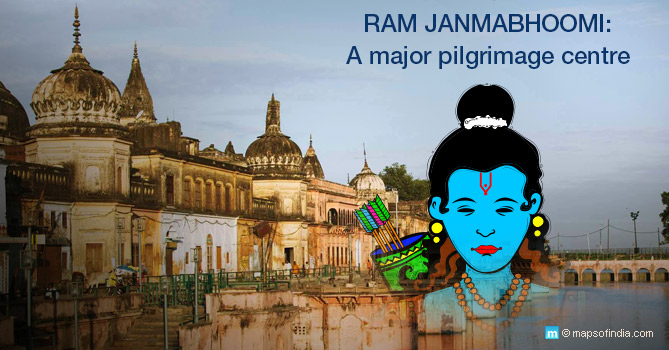 Ram Janmabhoomi is one of the major pilgrimage centres for the Hindus of India. This is a vast complex where there are remnants of an old temple. This temple is believed to be the site of a palace where Lord Ram was born. Another part of the complex houses a mosque that was built here during the Mughal era. If one is willing to look beyond the bitter communal disputes and politicking that has taken place over the Ram Janmabhoomi, this is the perfect place to see how India has assimilated various religions and cultures as part of her social fabric and how all these differences exist together as parts of a beautiful whole.
Ram Janmabhoomi is one of the major pilgrimage centres for the Hindus of India. This is a vast complex where there are remnants of an old temple. This temple is believed to be the site of a palace where Lord Ram was born. Another part of the complex houses a mosque that was built here during the Mughal era. If one is willing to look beyond the bitter communal disputes and politicking that has taken place over the Ram Janmabhoomi, this is the perfect place to see how India has assimilated various religions and cultures as part of her social fabric and how all these differences exist together as parts of a beautiful whole.
Getting There
Ram Janmabhoomi is located in the town of Ayodhya, some 8 kilometres from the city of Faizabad to the south of the state of Uttar Pradesh.
Rail Connectivity – As a Hindu pilgrimage destination, there is a railway station at Ayodhya that offers rail connectivity with the rest of the state. The rail station at Faizabad, however, is a major station and offers rail connectivity with major Indian cities including Delhi, Agra, Mumbai, Varanasi, Ahmedabad, and Kolkata (Howrah and Sealdah).
Nearest Airport – Lucknow, the capital city of Uttar Pradesh, is at a distance of about 140 kilometres from Ayodhya and houses the nearest airport. Lucknow’s Chaudhary Charan Singh Airport is an international airport and connects the state with the rest of the country and also some international destinations.
Bus Services – Ayodhya is connected with the rest of the state through excellent bus services plying to destinations such as Gonda (51 kilometres), Sravasti (109 kilometres), Gorakhpur (132 kilometres), Lucknow (134 kilometres), Allahabad (166 kilometres), Varanasi (209 kilometres), and Jhansi (441 kilometres).
Getting Around – Taxis are available in the city but are rather expensive. Tongas and tempos are common means of intra-city transport.
Hindu Mythology
According to Hindu mythology and Puranic lore, Rama was one of the ten avataars of Lord Vishnu, the cosmic preserver. To keep a promise he had made, Vishnu was born as the first son of King Dasharath and crown prince of the kingdom of Kosala. Ayodhya, the capital of Kosala, is believed to be Rama’s birthplace. Rama was sent to the forest with his wife and brother to fulfill his father’s promise to his step mother. In the course of these 14 years, Rama’s wife was abducted by a demon called Ravana and an epic war was waged to regain her. A victorious Rama returned to rule from Ayodhya for many years. The city of Ayodhya, also called Saket, was the seat of the Sun Dynasty rulers and a very sacred city, according to Hindu scriptures. According to Jain religious scriptures, the first Tirthankara, Adinath and four other Tirthankaras were born in the city of Ayodhya.
Shrines inside the Complex
In the city of Ayodhya, it is said that there are about 6000 shrines. It is, however, undoubted that the shrines within the Ram Janmabhoomi complex at Ramkot are deemed most sacred. Some of the major Hindu shrines in this complex include –
• Ram Janmabhoomi – The room where Rama is believed to have been born.
• Sita Rasoi – Sita’s kitchen; Sita was Ram’s wife and believed to be an incarnation of Goddess Lakshmi.
• Keikai Bhawan – The chambers of Keikai, Ram’s step-mother. The place where Bharat was born.
• Kaushalya Bhawan – The chambers of Kaushalya, Ram’s mother.
• Sumitra Bhawan – The chambers of Sumitra, Ram’s step-mother.
• Angad Tila – Shrine dedicated to Angad, the vanara prince.
• Lav Kush Temple – Shrine dedicated to Lav and Kush, Ram and Sita’s sons.
• Hanuman Mandir – Shrine dedicated to God Hanuman.
• Rang Mahal – The royal entertainment chamber.
Apart from these, there are hundreds of Hindu temples and shrines, mosques, and Jain temples in Ayodhya that make the city a beautiful one.
History
Taking Hindu mythological records into account, it may be said that the city of Ayodhya over which Ram reigned existed as far back as the Tretha Yug 3 or about 900,000 years ago. This city was rediscovered by King Vikramaditya who rebuilt the temple at the site of Ram Janmabhoomi, Hindus say. If religious records are discounted, historians suggest that the current city of Ayodhya dates back to at least the 7th century AD. It seems a temple of some sort existed at the spot in 1528 when Mir Baqi, a general of the Mughal Emperor Babur raised a mosque at the spot. Ever since, the Ram Janmabhoomi has been at the centre of much conflict and an ongoing tussle. According to news reports from 2003, the Archeological Survey of India seems to have found proof of the Ram temple’s existence predating the mosque at this site. The ASI report, however, is not available in public domain.
Visitor Information
Since bitter disputes and communal violence broke out at the Ram Janmabhoomi, this area is manned by armed security officials round the clock. Visitors are requested to abstain from carrying weapons or suspicious articles. Some shrines may be inaccessible due to security reasons.
Visit timings:
Summers – 7.30 am to 11.30 am and 4.30 pm to 9.30 pm
Winters – 9 am to 11 am and 4 pm to 9 pm
Ram Navami, Dussehra, and Diwali are the biggest festivals celebrated at the Ram Janmabhoomi. Many song and dance programmes are held across Ayodhya, temples undertake special pujas, and thousands of devotees head to the temple.
Dispute and Communal Violence
Ram Janmabhoomi in Ayodhya has been the site of religious dissent and much bitterness all through history. In 1992, however, clashes between Hindus and Muslims escalated to unprecedented levels causing disturbances all over the country and affecting the lives of many hundreds. Part of the mosque was demolished and in retaliation, more violence followed. The case was discussed and debated much at the Allahabad High Court which ruled that the area be divided in three parts and handed to three religious organizations for administration. The appeal with the Supreme Court of India still remains pending. We, the citizens of India, can only hope that the verdict brings more peace and harmony to the country and strengthen the social fabric.
Read More…





